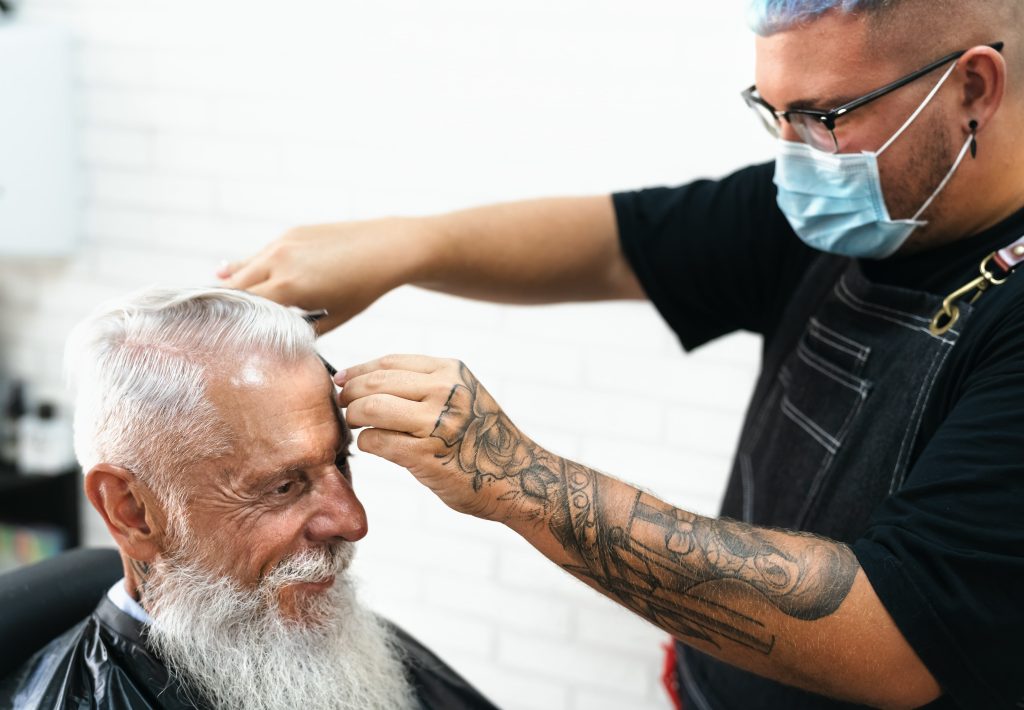What Is FUE Hair Transplant?
FUE (Follicular Unit Extraction) is a modern hair transplant technique based on the principle of harvesting hair follicles one by one from the donor area (usually the back of the head) using a micromotor or manual tools and placing them into micro-channels opened in the recipient area. Since this method does not require a surgical incision or stitches, it does not leave a noticeable scar in the donor area, and the healing process is quite fast. This method is often preferred for situations where a large area needs to be transplanted or when aiming for a higher number of grafts.
What Is DHI Hair Transplant?
DHI (Direct Hair Implantation) or Direct Hair Transplant is an advanced version of the FUE method. In this technique, hair follicles are harvested one by one from the donor area with a special tool called the Choi Pen (DHI Pen). Then, the harvested hair follicles are placed directly into the recipient area without a channel opening procedure. The Choi Pen performs both the channel opening and the follicle placement simultaneously, minimizing the time the grafts spend outside the body. This increases the survival rate of the grafts and allows for a denser implantation.
Which Method Is Newer and More Modern?
The DHI (Direct Hair Implantation) method is considered newer and more modern compared to FUE. While FUE was a breakthrough that revolutionized hair transplantation and replaced the FUT method, DHI builds upon this method, focusing on increasing precision and efficiency. DHI stands out by combining the channel opening and graft placement stages, which gives the surgeon more control. This makes DHI a more detail-oriented and state-of-the-art method.
Which Method Is Suitable for a Higher Number of Grafts?
The FUE method generally allows for a higher number of grafts to be harvested and transplanted in a single session. The FUE technique uses micromotors to quickly harvest grafts from a large area, making it possible to transplant more than 4000 grafts in a single operation. The DHI method is more time-consuming because each graft must be placed one by one with the Choi Pen, and the number of grafts that can be implanted in a single session is generally more limited compared to FUE. Therefore, FUE is more frequently preferred for large areas.
Which Method Provides a More Natural Look?
While both methods can yield natural results in the hands of an experienced surgeon, the DHI method offers the potential to create a more natural and aesthetic hairline. This is because the angle, direction, and depth of the grafts can be controlled more precisely with the Choi Pen. Especially when implanting between existing hairs or when the goal is to increase hair density, DHI ensures a more natural growth direction. A natural result can also be achieved with FUE, but it is more difficult to reach the level of precision that DHI provides.
Which Method Has a Higher Graft Survival Rate?
The DHI method is considered to have a higher graft survival rate because it minimizes the time the grafts spend outside the body. In FUE, grafts are harvested, kept outside for a while, and then placed into the opened channels. In DHI, grafts are implanted directly with the special pen immediately after harvesting. This process prevents the grafts from being exposed to air and drying out, which helps them stay healthy. Therefore, it is expected that DHI-implanted hairs will have a higher success rate.
Which Method Is More Expensive?
Generally, the DHI method is more costly compared to FUE. The main reasons for this price difference are the cost of the special Choi Pen tool used in DHI and the fact that the operation requires more technical skill and time. DHI requires the surgeon to perform more detailed and precise work, which also increases the labor cost. FUE can provide similar quality results while being a more economical option. Therefore, budget is an important factor in method selection.
What Is the Difference in Procedure Time Between FUE and DHI?
The procedure time for FUE and DHI methods varies depending on the number of grafts to be implanted. However, generally, the DHI method can take longer than FUE. This is because in DHI, both the channel opening and graft placement are performed in a single step for each individual graft. In FUE, these procedures are performed in separate stages, and the harvesting of grafts can be faster. For example, a 4000-graft DHI operation can take up to 10 hours, while a similar FUE operation can be completed in a shorter time.
Which Method Is Suitable for Short Hair?
Both methods require the hair to be shaved, but in DHI, a smaller area of shaving may be sufficient. The FUE method generally requires the entire donor area to be shaved. In DHI, the operation can be performed by only shaving the area to be implanted, which is an advantage for patients who wear their hair long. Therefore, both methods can be suitable if the hair is kept short as they do not leave scars, but DHI offers more flexibility.

Which Method Is More Suitable for a Second Transplant?
When a second hair transplant is needed, the FUE method is generally seen as a better option. FUE offers the opportunity to harvest grafts from areas not damaged in the first operation and better preserves the potential of the donor area. If DHI was performed in the first operation and the donor area was overused, FUE can be preferred for a second transplant. However, the most accurate decision should be made by the surgeon after examining the condition of the donor area and the current hair density.
Is the Main Difference Between FUE and DHI the Channel Opening?
Yes, one of the most fundamental differences between FUE and DHI is the channel opening procedure. In FUE, micro-channels are opened in the recipient area before the hair follicles are harvested. In DHI, the channel opening procedure is not performed. Instead, the harvested hair follicle is placed into a special tool called the Choi Pen, and this pen opens a channel and places the graft in a single motion. This significantly reduces the time the grafts spend outside the body and increases their chance of survival.
How Densely Can Grafts Be Implanted with DHI?
The DHI method offers the ability to implant grafts much more closely and densely. Thanks to the thin tip of the Choi Pen, hair follicles can be placed very close to each other. This is a great advantage, especially for regions with low hair density or for making the hairline more distinct and natural. A dense transplant can also be done with FUE, but it can be more difficult to achieve the level of precision and density that DHI provides.
Which Method Causes Less Damage to Hair Follicles?
Both FUE and DHI methods are designed to cause minimal damage to hair follicles, but DHI’s potential to protect grafts is higher. Since grafts are implanted immediately after harvesting in DHI, their exposure to external factors (air, temperature, etc.) is minimized. In FUE, the harvested grafts are kept outside for a while, which can increase the risk of damage to the sensitive hair follicles. Therefore, DHI better protects the health of the grafts.
What Causes the Price Difference Between FUE and DHI?
The price difference between FUE and DHI stems from several main reasons. First, the cost of special and more advanced tools like the Choi Pen used in DHI is higher. Second, the DHI operation is a longer process that requires more technical skill, which increases the labor cost of the surgeon and the team. Third, the high graft survival rate and aesthetic results provided by DHI are also factors that drive up the price.
Which Method Is More Suitable for Fine Hair?
In fine hair, a denser implantation is needed to create a feeling of fullness. Therefore, the DHI method may be more suitable for fine hair. DHI’s ability to implant grafts very densely makes the overall appearance of the hair look fuller. FUE can also be used, but it can be difficult to achieve the high density that DHI provides. As a result, hair type also plays an important role in the choice of method.
Which Method Is More Suitable for Loose Skin?
Skin structure is a factor that affects the success of a hair transplant operation. In patients with loose skin, both FUE and DHI methods can be applied, but the precision advantage of DHI may stand out. In DHI, since grafts are placed directly into the skin, the skin’s elasticity affects the quality of the implantation less. In FUE, the channel opening procedure can be more difficult on loose skin and may affect the correct angle of graft placement.
Which Method Causes Less Pain?
Since both FUE and DHI methods are minimally invasive, they offer a painless experience under local anesthesia during the operation. After the operation, a mild ache may be felt with FUE, while this ache may be even less with DHI. DHI’s inclusion of the channel opening procedure minimizes the trauma to the recipient area. Therefore, DHI is generally considered less painful in the post-operative period, and patients recover more quickly.
Which Factors Are Important in Choosing a Method?
Many factors should be considered when choosing a method. These include the level of hair loss, the quality of the donor area, the patient’s hair type, budget, and expectations. For example, a patient with a limited budget may prefer FUE, while a patient who wants to increase hair density and achieve a more natural hairline may prefer DHI. The most accurate decision should be made as a result of a detailed consultation with an experienced surgeon.
What Are the Differences Between FUE and DHI Methods?
The main differences between FUE and DHI are as follows:
- Channel Opening: In FUE, channels are opened before the grafts, while in DHI, this is done simultaneously with the graft using the Choi Pen.
- Graft Waiting Time: In DHI, grafts are implanted immediately after being harvested, so their time outside the body is minimal.
- Price: DHI is generally more expensive than FUE.
- Procedure Time: DHI operations generally take longer than FUE.
- Density: DHI provides a denser implantation compared to FUE. These differences lead patients to prefer different methods based on their needs.
What Are the Main Risks Associated with FUE?
The risks associated with FUE are generally minimal. Possible risks include infection, bleeding, thinning due to excessive harvesting in the donor area, and an unnatural look resulting from incorrect graft placement. These risks can increase, especially in operations performed by an inexperienced surgeon. However, these risks are minimized in an operation performed by an experienced surgeon and in hygienic conditions.
What Are the Main Risks Associated with DHI?
The risks associated with DHI are similar to FUE and are generally minimal. The most significant risk of DHI is the experience of the surgeon performing the operation. Since the use of the Choi Pen requires a high level of skill, there may be a risk of grafts being implanted at the wrong angle or being damaged in inexperienced hands. Additionally, DHI’s potential for denser implantation can lead to overuse of the donor area and thinning in the future.
Which Method is More Suitable for Beard and Eyebrow Transplants?
Operations in sensitive areas like beard and eyebrow transplants are situations where achieving a natural look is critical. Therefore, the DHI method is considered a more suitable option for these procedures. Thanks to the precise control provided by the Choi Pen, each hair follicle can be placed at the correct angle and in the correct direction. This makes it possible to achieve aesthetic and permanent results that are consistent with the natural structure of beards and eyebrows.
Is There a Difference in Post-Operative Care Between FUE and DHI?
The post-operative care processes in FUE and DHI methods are quite similar. In both methods, it is recommended to protect the recipient and donor areas for the first few days after the operation, avoid getting them wet, and refrain from strenuous activities. However, because the channels in DHI are smaller, the scabbing and healing process can be slightly shorter. In both methods, following the doctor’s instructions is vital for a successful outcome.
What Are the Advantages of FUE?
The main advantages of FUE are:
- No permanent scar: Only punctate scars form, and they disappear in a short time.
- Fast healing: Patient comfort is high because it is minimally invasive.
- High graft number: It allows for the implantation of a large number of grafts in a single session.
- Low cost: It is generally more economical compared to DHI.
- Body hair use: Beard or chest hair can be used when the donor area is insufficient.
What Are the Disadvantages of DHI?
The main disadvantages of DHI are:
- High cost: It is more expensive than FUE.
- Longer operation time: Implanting each graft one by one takes a longer time.
- Limited graft number: An insufficient number of grafts may be implanted in a single session for large areas.
- Surgeon’s experience: The use of the Choi Pen requires a high level of skill, so the doctor’s experience is much more critical.
Which Method Causes Less Damage to the Donor Area?
Both FUE and DHI methods cause less damage to the donor area compared to FUT. However, in DHI, the fact that each graft is harvested and implanted immediately helps minimize the trauma to the donor area. In FUE, the use of a micromotor can cause a slightly more damage to the hair follicles in the donor area. However, it is possible for an experienced surgeon to perform the procedure without damaging the donor area in both methods.
Is There a Difference in Results Between FUE and DHI?
The results vary depending on the surgeon’s ability and the patient’s individual characteristics. However, generally, the DHI method has the potential to achieve a higher density and a more natural-looking hairline. Very successful results can also be achieved with FUE, but the precision offered by DHI can make a significant difference, especially in areas where aesthetics are a priority, such as the front hairline.
Is DHI Safer Than FUE?
Both FUE and DHI are proven methods in terms of safety and do not carry major surgical risks. However, since the DHI method reduces the time the grafts spend outside the body, it lowers the risk of hair follicles being exposed to infection or drying out, which is an advantage in terms of graft health. In general, the safety of both methods depends on the hygiene standards of the clinic where the operation is performed and the surgeon’s experience.
Which Method is Suitable for Creating a Hairline?
The hairline is one of the most important aesthetic elements of hair transplantation. The DHI method is more advantageous in this area as it offers more control and precision for creating the hairline. The DHI pen makes it possible to place grafts one by one, at the correct angle and in the correct direction, which ensures the hairline looks natural. FUE can also be used, but the millimeter-level control in DHI can create more aesthetic results.

What Is the Scarring Situation with FUE and DHI?
Neither FUE nor DHI methods leave a permanent and noticeable scar in the donor area. Only very small, punctate scars form where the hair follicles are harvested. These scars heal within a few weeks and become completely invisible when the hair grows out. This is a great advantage, especially for patients who want to wear their hair short, and it is one of the most important reasons why both methods are more popular than FUT.
Who Should Determine the Choice Between FUE or DHI?
You should determine the choice between FUE or DHI together with your doctor. An experienced hair transplant surgeon will evaluate the level of your hair loss, the condition of your donor area, and your hair structure to determine the most suitable method for you. At the same time, they will offer you the most suitable treatment plan by considering your expectations and budget. Therefore, having a comprehensive pre-consultation and asking all your questions is of great importance.
Which Method Is Suitable for Increasing Density?
For patients who already have hair but want to increase the density in sparse areas, the DHI method is a more suitable option. Since there is no channel opening procedure in DHI, hair follicles can be implanted directly between the existing hairs. This allows the hair follicles to be placed much closer to each other and, therefore, to achieve a higher density. In FUE, this procedure can be more difficult and risky.
How Are FUE and DHI Performed?
In the FUE procedure, after the donor area is shaved, local anesthesia is applied. Then, hair follicles are harvested one by one with the help of a micromotor. The harvested grafts are kept in a special solution. After that, channels are opened in the recipient area, and the grafts are placed into these channels. In the DHI procedure, the grafts harvested from the donor area are placed into the Choi Pen and injected directly into the recipient area.
Which Method Provides Faster Results?
It takes about 12 to 18 months for the full results of hair transplantation to appear for both methods. However, in terms of the immediate post-operative period, the direct implantation of grafts in the DHI method can help reduce post-operative swelling and bruising. This contributes to the patient having a faster healing process. However, the process of new hair growth and maturation is similar in both methods.
Which Method is Suitable for People with Advanced Baldness?
People with a high stage of baldness usually need a large number of grafts to be implanted over a large area. In this case, the FUE method, which provides a higher number of grafts in a single session, may be more logical. With FUE, it is possible to cover a larger area and achieve results more quickly. DHI is more suitable for patients who have partial hair loss or who want to increase their hair density.
What Factors Affect the Price of FUE and DHI?
Factors that affect the price of FUE and DHI include the number of grafts to be implanted, the location of the clinic, the surgeon’s experience, the technology used, and the implantation method itself. The fact that DHI is more expensive than FUE is due to the special tools used and the need for more technical skill. However, the price for both methods can vary greatly from clinic to clinic.
Is FUE and DHI a Service of a Single Clinic?
Yes, today most hair transplant clinics offer both FUE and DHI methods. It is important to be proficient in both techniques to determine the most suitable method for the patient’s needs. This way, the surgeon can help the patient make the right decision based on their hair loss condition, budget, and expectations. Consulting at a clinic that offers both methods provides a better comparison opportunity.
Which Method is Recommended for Which Patients?
- FUE: It is recommended for those with a limited budget, those who want to transplant a very large area, those who like to wear their hair short, and those who are considering a second transplant.
- DHI: It is recommended for those who want high density and a natural hairline, those who want beard or eyebrow transplants, those who want to wear their hair long and not have the operation noticed, and those who are looking for a faster healing process.
Which Method is More Popular and Why?
The FUE method remains a more popular option due to its cost-effectiveness and its appeal to a wide range of patients. However, DHI is gaining increasing demand due to the superior aesthetic results and higher graft survival rate it offers. The competition between the two methods is constantly advancing hair transplant technologies.



